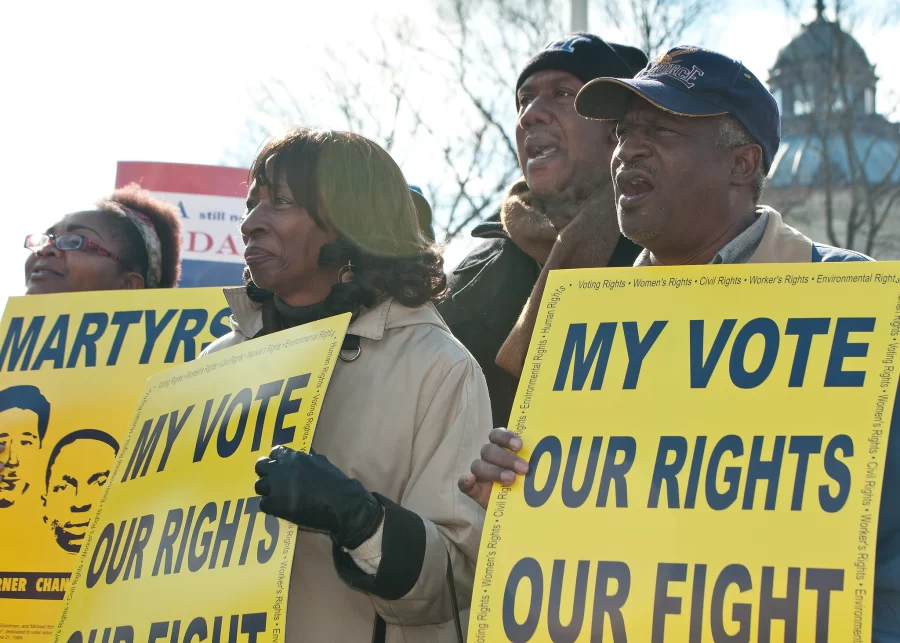Opinion | ‘Race-blind’ redistricting contradicts Constitution
Photo courtesy of David Sachs/SEIU/Flickr
A rally in front of the Supreme Court where justices were hearing cases on the Voting Rights Act on Feb. 27, 2013.
Oct 21, 2022
In a year that’s already seen the monumental Supreme Court decisions regarding carbon emission regulations, second amendment rights and abortion access, the high court’s second term of the year has just begun — and the conservative bloc of justices is poised to deliver the fatal blow to Voting Rights Act of 1965.
The VRA was a landmark piece of legislation aimed at protecting against discriminatory election laws and practices by states. Unfortunately, through narrow Supreme Court decisions over the past decade, its key provisions have been gradually stripped back.
In a 5-4 decision in 2013, the Supreme Court invalidated Section 5 of the VRA, which subjected states with demonstrated histories of voter discrimination to federal oversight before changing their election laws. In 2021, the Supreme Court delivered another ideologically divided decision that upheld an Arizona voting law a district court declared to be discriminatory under the VRA — this decision weakened all lower courts’ ability to block discriminatory voting laws using the VRA.
After landing two haymakers over the last nine years, the Supreme Court’s conservative majority is winding up to throw the knockout punch that will effectively leave the VRA toothless.
Merrill v. McGill, the case presently being heard by SCOTUS, is concerned with whether Alabama’s newly redrawn voting districts violate Section 2 of the VRA. This section in particular disallows election practices — a term which encompasses redistricting — that result in “a denial or abridgment of the right to vote based on race.”
Get The Daily Illini in your inbox!
The plaintiff argues that Alabama’s new congressional map does just this, citing how it packs the majority of the state’s Black voters into a single district while spreading the rest over the remaining six districts in a way that intentionally dilutes the Black voters’ ability to elect their desired candidates. This phenomenon is known as “vote dilution.”
For reference, Alabama’s population is 26.8% Black. But under the current congressional map, Alabama contains only one majority-Black district.
This challenge came before a three-judge panel in Alabama earlier this year. The panel — which contained two Trump-appointed judges — sided with the plaintiff, deciding that Alabama’s new congressional map “likely violated” the VRA by “diluting Black voting strength.”
In February, however, SCOTUS offered a terse rebuttal by blocking the lower court’s ruling, forcing the new map to go temporarily into effect for the 2022 midterm elections while the Supreme Court debates the issue.
The principal argument from the state of Alabama — represented in court by State Solicitor General Edmund LaCour — is that Section 2 of the VRA is unconstitutional because ordering Alabama to draw a second majority-Black district would require the state to sort voters by race, which is prohibited by the 14th and 15th Amendments.
Thus, LaCour contends, Alabama is in line with constitutional law by excluding race as a factor in drawing its congressional map — what he called a “race-neutral” approach. While at face value this argument appears to adhere to the Constitution, it prompts one to recount why exactly the 14th and 15th Amendments were adopted in the first place.
Upon considering this question, one thing becomes clear: The concept of “race-blindness” is completely antithetical to the purpose of these amendments. In fact, the drafters of the 14th and 15th Amendments had race at the very top of their minds.
In just her second-ever day of oral arguments, the newly appointed Justice Ketanji Brown Jackson elucidated this point superbly. Justice Jackson asserted that “the framers themselves adopted the equal protection clause, the 14th Amendment, the 15th Amendment, in a race conscious way,” which was to “ensure that people who had been discriminated against … were actually brought equal to everyone else in society.”
By appealing to the original intent of the drafters — a method of constitutional interpretation typically employed by conservative judges — Justice Jackson exposed LaCour’s argument for what it is: a gross misconstruing of the purpose of the 14th and 15th Amendments.
As poignantly explained by Justice Jackson, they were drafted “to give a constitutional foundation for a piece of legislation (the Civil Rights Act) that was designed to make people who had less opportunity and less rights equal to white citizens.”
Put plainly, the argument that state legislatures should turn a blind eye to race when drafting their congressional maps is at odds with the Constitution. To ensure the equal protection of all American voters, it is essential that new districts are drawn in such a way that does not dilute the voting power of any one group based on race.
As Justice Kagan pointed out, it will be “extremely difficult” to protect against vote dilution without Section 2 of the VRA. And considering the Court majority’s evident proclivity toward striking down 40-plus years of standing precedent, American voters must brace for a ruling that will likely declaw the VRA once and for all.
Nick is a senior in LAS.






